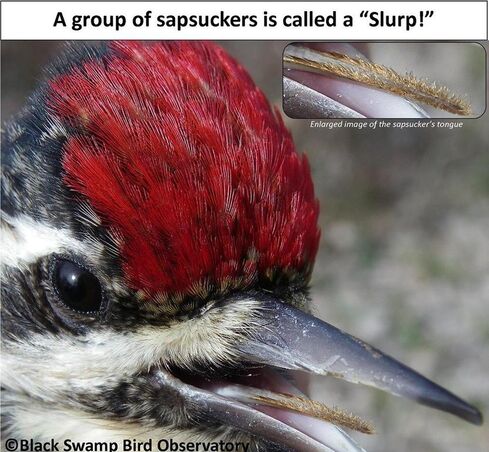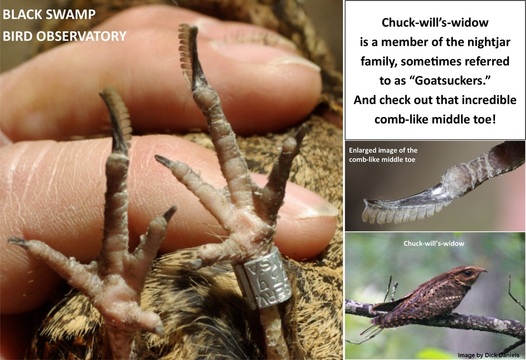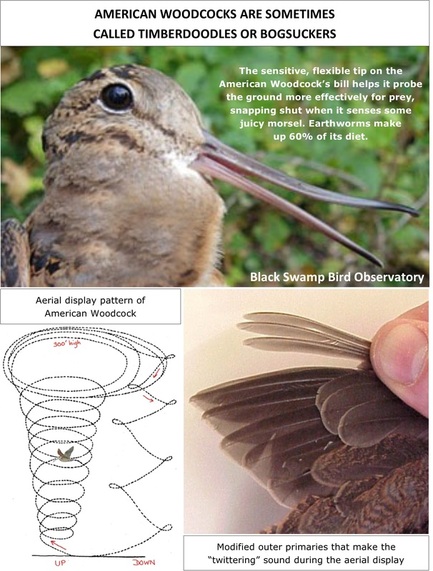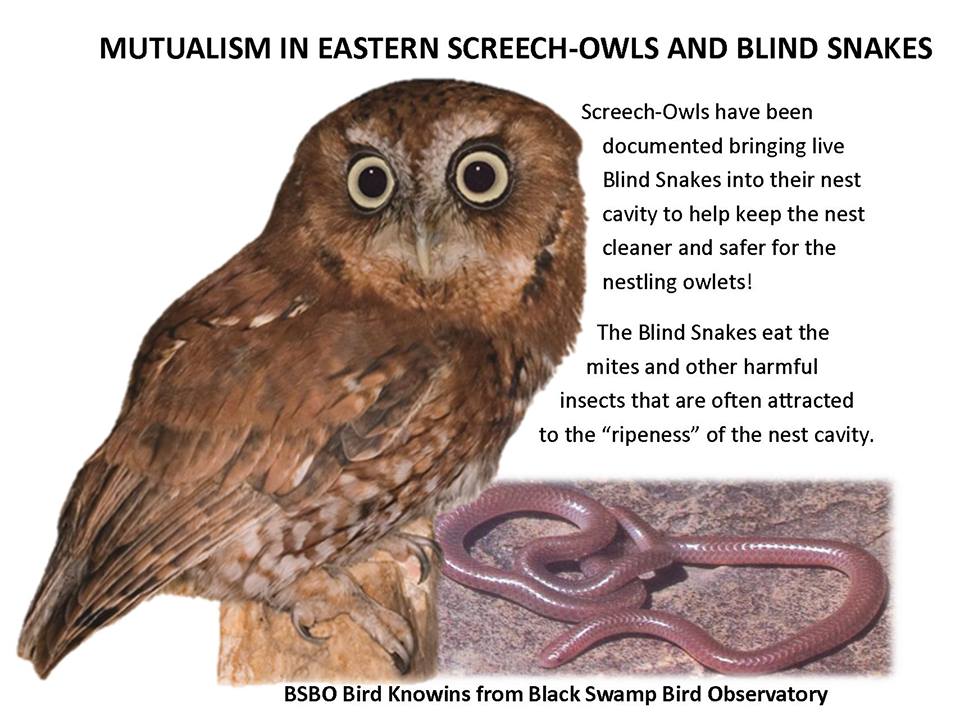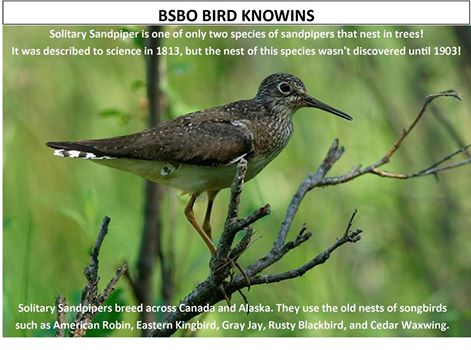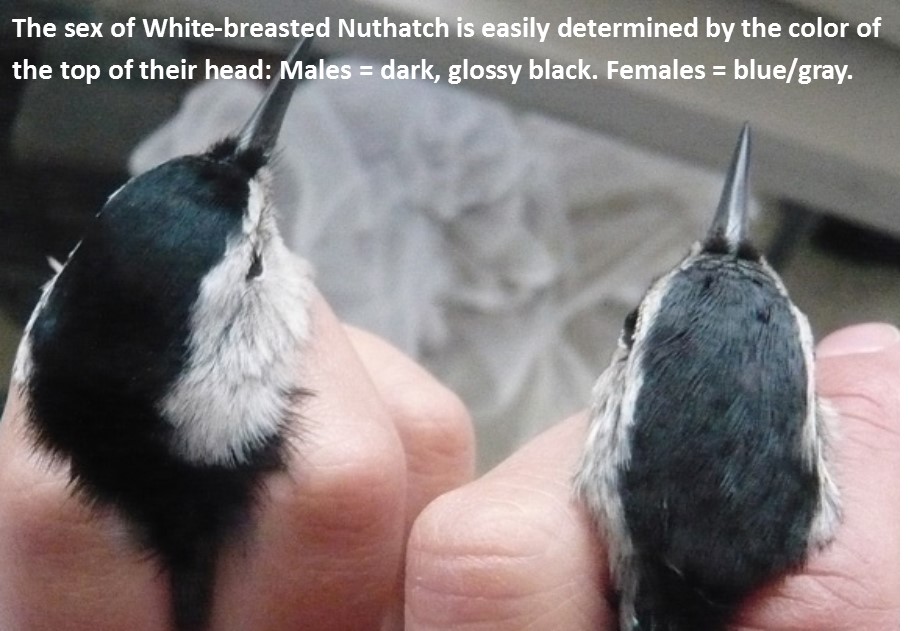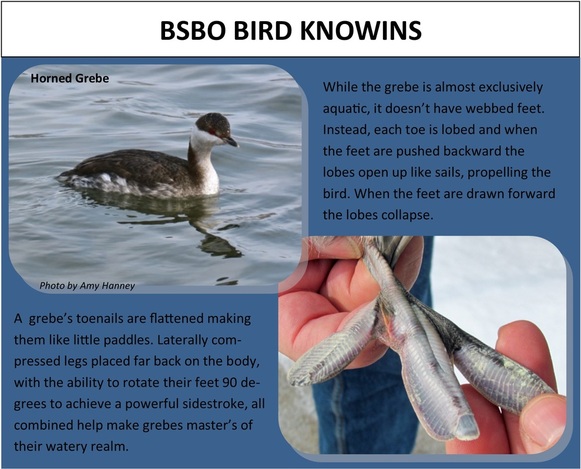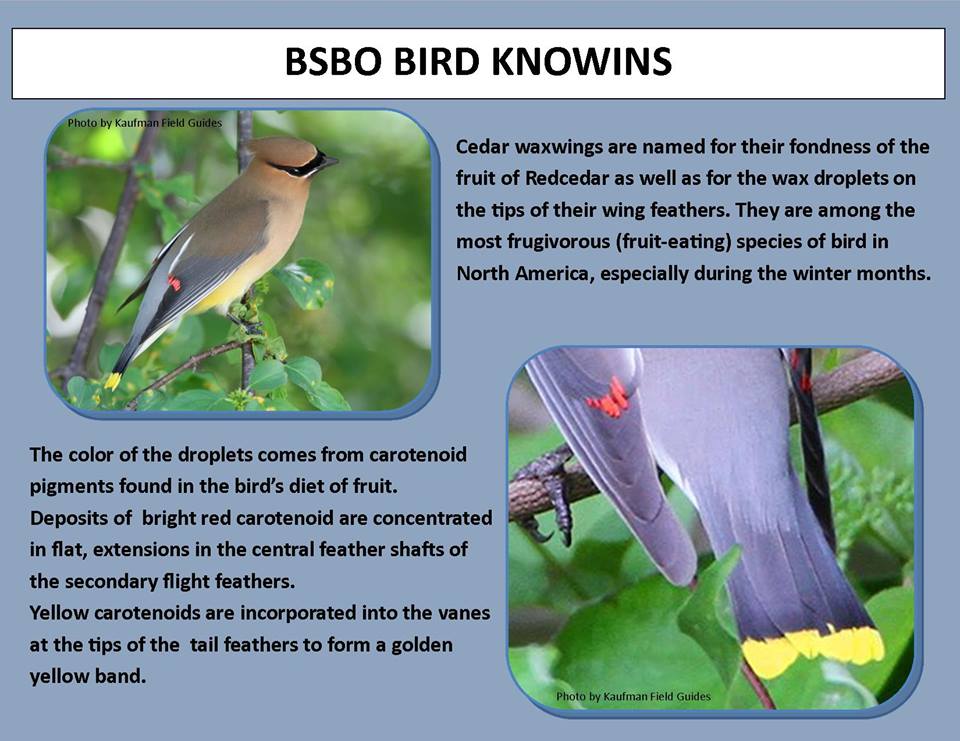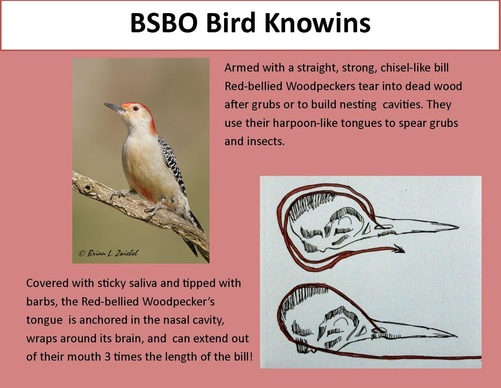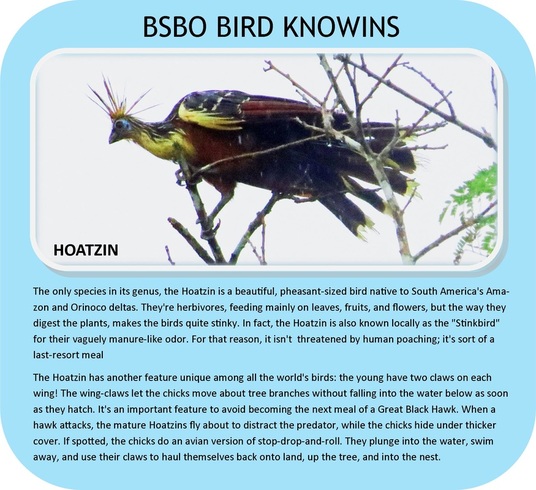BSBO BIRD KNOWINS: Fun, fascinating facts about birds!
BSBO Bird Knowins is a regular series that will reveal some of the coolest and most bizarre bird adaptations and behaviors! We'll post each installment on Facebook first, so get all the latest Bird Knowins, follow BSBO on Facebook.
Yellow-bellied Sapsucker
|
Our first edition of BSBO Bird Knowins features the Yellow-bellied Sapsucker's specialized tongue. The end of the sapsucker's tongue has bristle-like hairs that collect and soak up sticky sap. Contrary to their name, sapsuckers don't actually suck up sap, rather, they lap it up using that wicked-cool tongue adaptation! (But somehow the name "Saplapper" doesn't seem quite as catchy!)
|
Chuck-will's-widow
|
Our second installment of #BSBOBirdKnowins brings you a very special look at Chuck-will’s-widow! Click on the photo for a larger view and please feel free to share.
Named for its song, Chuck-will’s-widow is the largest North American member of the nightjar family. They are sometimes called “goatsuckers” because folklore once told that they sucked milk from goats. “Chucks” and other nightjars have very tiny bills, but when the bill opens, it reveals an enormous, gaping mouth perfect for gulping insects out of the air. Since they do very little walking, nightjars have extremely short legs and small feet, but check out the remarkable adaptation on the middle toe! Although not proven, that comb-like adaptation may be used to clean the rictal bristles (stiff, spine-like feathers around the mouth). Chuck-will’s-widow populations are in decline and they are considered species of special concern. This is likely linked to the increasing use of pesticides. Learn more by visiting www.nightjars.org |
American Woodcock
|
Like nature’s example of Mr. Potato Head, American Woodcocks appear to be birds made of spare parts. A plump, round body, very short legs, a small head with bulging eyes, and a bill that seems to long for its face, they still somehow manage to look amazing!
Members of the sandpiper family, woodcocks are shorebirds that don't live on or near the shore. Instead, they prefer moist, shrubby fields and young forests where they probe the earth for earthworms and insects. And that fabulously long bill has a flexible tip that helps it probe more effectively, essentially “feeling” for prey, and snapping shut when it senses some juicy morsel! American Woodcocks are known for the spectacular courtship flight, or “Sky Dance” of the male. He begins on the ground with a series of loud, nasal, “PEENTS,” before spiraling up into the sky, then slowly drifting down in a waffling flight accompanied by a soft twittering sound. That twittering sound isn’t vocal! The sound is made by modified, narrow outer primaries—feathers that “sing!” |
Eastern Screech-Owl
|
This installment of #BSBOBirdKnowins takes a peek into the nests of Eastern Screech-Owls!
Eastern Screech-Owls have been documented bringing live Blind Snakes into the nest cavity to keep it cleaner and safer for the nestling owlets! Screech-owls feed a variety of small animals to their young, and like most raptorial birds, prey is usually killed at the point of capture before bringing it home to feed to their nestlings. With dead morsels being delivered to the nest--along with fecal matter, pellets, and uneaten prey--the nest cavity can get pretty ripe, attracting mites and insects that can potentially harm the nestling owlets. Here’s where the Blind Snakes come in! Researchers found that the nests with Blind Snakes had significantly fewer harmful mites and insects, and that the owlets from nests with Blind Snakes were 25% more likely to survive and grew as much as 50% faster! The Blind Snakes get food and the owlets are free from harmful insects. A wonderful example of two organisms of different species benefiting from a relationship! |
Solitary Sandpiper
|
This week's #BSBOBirdKnowins takes a closer look (UP) into the nest of the Solitary Sandpiper!
Solitary Sandpiper (Tringa solitaria), beloved for being one of the less challenging shorebirds to identify, held a major secret for many years. It was described to science by Alexander Wilson in 1813, but the nest of this species wasn't discovered until 1903! Why, you ask. Because Solitary Sandpiper isone of only two species of sandpipers that nest in trees! They use the old nests of songbirds such as American Robin, Rusty Blackbird, Gray Jay, and Cedar Waxwing. For years, Solitary Sandpiper nests and eggs were confused with those of Spotted Sandpipers. Their life cycle remains among the most poorly known of North American shorebirds, especially on the breeding grounds. (Photo from USFWS.) (The other tree-nesting sandpiper is the Green Sandpiper (Tringa ochropus), an Old World species.) |
Sexual Dimorphism
|
This week's installment of #BSBOBirdKnowins is a lesson in sexual dimorphism. Sexual dimorphism means that males and females of the same species look different. The difference can be in size or plumage. In some species, like Northern Cardinal and Red-winged Blackbird, the difference in plumage is quite obvious. But even some birds that look the same at a glance, reveal subtle differences when we take a closer look!
White-breasted Nuthatches are a wonderful example! And the same is true of American Robins, the male having a darker, blacker head and richer color on the chest than the female. |
Horned Grebe
|
This week's #BSBOBirdKnowins is in honor of the Horned Grebe that BSBO helped successfully rescue and release a few days ago. Please feel free to share and help spread the Bird Knowins with your Facebook friends and family!
To learn more about Horned Grebes, check out Audubon's brand spanking new online Guide to North American Birds! |
Cedar Waxwing
|
This week’s #BSBOBirdKnowins takes a look at the fruit loving Cedar Waxwing.
The Cedar Waxwing is a bird with a very specialized diet, feeding predominantly on sugary fruits for almost 7 months of the year. Waxwings are known to eat a variety of fruits from dogwood, viburnums, grape, pokeweed, and junipers. The bright red waxy “droplets” on the secondary feathers and their fondness for the fruits of Eastern Redcedar (Juniperus virginiana) gave Cedar Waxwings their name. |
Red-bellied Woodpecker
|
This week #BSBOBirdKnowins helps us wrap our brains around the amazing tongue of the Red-bellied Woodpecker!
We often see Red-bellied Woodpeckers clambering up the sides of trees, working along limbs, tapping, pecking, and turning their heads to listen for scurrying insects and chewing grubs under the tree’s surface. Red-bellied Woodpeckers use their straight, strong, chisel-like bills to tear into dead wood and then use their sticky saliva, barb-tipped tongue to spear grubs and other insects. The Red-bellied Woodpecker’s tongue is anchored in the nasal cavity, wraps around its brain, and can extend out of their mouth 3 times the length of the bill! Red-bellied Woodpecker photo by Brian Zwiebel Woodpecker skull sketch by Lester Peyton |
Hoatzin
|
The only species in its genus, the Hoatzin is a beautiful, pheasant-sized bird native to South America's Amazon and Orinoco deltas. They're herbivores, feeding mainly on leaves, fruits, and flowers, but the way they digest the plants, makes the birds quite stinky. In fact, the Hoatzin is also known locally as the "Stinkbird" for their vaguely manure-like odor. For that reason, it isn't threatened by human poaching; it's sort of a last-resort meal
The Hoatzin has another feature unique among all the world's birds: the young have two claws on each wing! The wing-claws let the chicks move about tree branches without falling into the water below as soon as they hatch. It's an important feature to avoid becoming the next meal of a Great Black Hawk. When a hawk attacks, the mature Hoatzins fly about to distract the predator, while the chicks hide under thicker cover. If spotted, the chicks do an avian version of stop-drop-and-roll. They plunge into the water, swim away, and use their claws to haul themselves back onto land, up the tree, and into the nest. |
